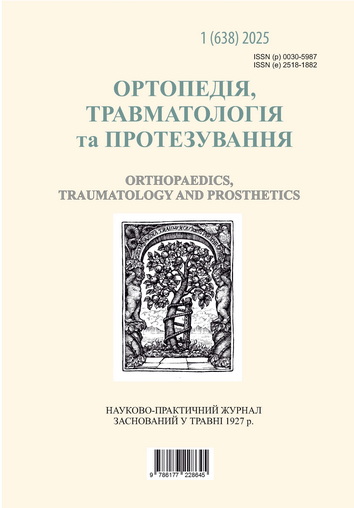FEATURES OF DEFORMATION OF THE «DEBRIS – EXTERNAL CORE APPARATUS» MODEL IN THE CASE OF USING STRUCTURES WITH DIFFERENT STRUCTURAL GEOMETRY
DOI:
https://doi.org/10.15674/0030-59872025165-74Keywords:
Femoral fracture, external fixation device, loadingAbstract
Objective. To study the linear and angular displacements of the "fragments" during their connection with an external rod apparatus manufactured by HB ORTHO (Ukraine) or Orthofix (USA) under different variants of the geometry of the "fragments – apparatus" structure in order to clarify the mechanical principles of its rational construction. Methods. The model was rigidly fixed at one end in a horizontal position, and a transverse force was alternately applied to the opposite end using weights of 1, 2, 3, 4, 5 kg. The experiment involved the study of the magnitude and nature of the displacement of the fragments depending on the following parameters of the rods: the number of rods in the fragment (2 or 3); diameter (5, 6 mm); length of the rod section from the bone to the support (100, 50 mm); length of the bone section between the extreme rods (150, 100 mm); the presence of a multi-plane arrangement of the rods and, in particular, when they formed a 45° angle between them, the number of external supports: one or two, located in parallel or side by side. Results. The first most important parameter that influenced the amount of displacement of the distal "fragment" was the distance from the bone to the support. In the case of a distance of 50 mm, the amount of displacement of the fragment is 2–4 times less than in the case of 100 mm. The second parameter that influenced the displacement of the fragments was the length of the bone section between the extreme rods screwed into the fragment. If it is reduced by 30 %, the displacement increases by 64% and almost does not depend on whether 2 or 3rods were used. It is possible to significantly reduce the displacement of the distal fragment (at least twofold) by inserting rods in different planes, in particular, by positioning the rod so that in the proximal fragment near the fracture in a plane that is 45° to the frontal plane. With a gradual transverse load, the deformation of the structure at the initial stages (1, 2, 3 kg) is elastic in nature and with an increase (up to 4–5 kg), residual deformation occurs due to: movement of the clamp on the cylindrical support; plastic deformation of the rods, which is inherent in HB ORTHO devices (Ukraine).
Downloads
How to Cite
Issue
Section
License
Copyright (c) 2025 Olexii Popsuishapka, Igor Subbota

This work is licensed under a Creative Commons Attribution 4.0 International License.
The authors retain the right of authorship of their manuscript and pass the journal the right of the first publication of this article, which automatically become available from the date of publication under the terms of Creative Commons Attribution License, which allows others to freely distribute the published manuscript with mandatory linking to authors of the original research and the first publication of this one in this journal.
Authors have the right to enter into a separate supplemental agreement on the additional non-exclusive distribution of manuscript in the form in which it was published by the journal (i.e. to put work in electronic storage of an institution or publish as a part of the book) while maintaining the reference to the first publication of the manuscript in this journal.
The editorial policy of the journal allows authors and encourages manuscript accommodation online (i.e. in storage of an institution or on the personal websites) as before submission of the manuscript to the editorial office, and during its editorial processing because it contributes to productive scientific discussion and positively affects the efficiency and dynamics of the published manuscript citation (see The Effect of Open Access).














